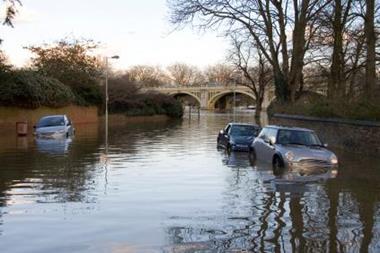Flood insurance programme must be reformed 'comprehensively'
The National Flood Insurance Programme (NFIP) must be reformed comprehensively to provide consumers with the level of protection they require and to achieve the participation the programme needs, according to the Property Casualty Insurers Association of America (PCI).
Don Griffin, PCI’s vice president of personal lines, testified Tuesday before the Senate Banking Committee on NFIP reform: “PCI believes that the NFIP is a necessary public policy response to an uninsurable peril,” Griffin said. “It has undergone significant changes over the years, yet it still continues to provide vital protection to policyholders nationwide. However, the programme as currently structured does not provide consumers with the level of protection needed and has not achieved the participation needed.”
Griffin laid out PCI’s agenda for strengthening the programme, including: responsible construction and mitigation programmes, including minimum building codes and incentives against overdevelopment in flood-prone areas; forgiveness of NFIP’s $17bn post-Katrina debts; a 10-year NFIP reauthorization; affirmation of federal court jurisdiction over flood claims; increased maximum coverage limits; and more flexibility for the Federal Emergency Management Agency (FEMA) in rate-making. Griffin told the committee that these reforms would make the NFIP more responsive to purchasers, more fiscally responsible, and better able to ensure that properties are protected against future losses
“The events of 2004 and 2005 have shown that the devastation caused by hurricanes and floods can impact millions of lives, businesses, and our nation. Even as those hardest hit continue to recover from these events, scientists tell us we will continue to see more frequent and more severe storms for another 10 years or more, so we need to be better prepared.”
In addition to the broad six-point agenda Griffin detailed, he also suggested a number of additional specific ideas to increase the NFIP’s effectiveness in providing the product to those most at risk and ensuring more consumers buy flood insurance. His ideas included:
• The standard flood insurance policy should be rewritten to make it more consistent with standard homeowners and other property/casualty insurance products.
• The programme should include at least some coverage for additional living expenses, business interruption coverage and the option to insure all buildings to their replacement cost value.
• The programme should provide more educational materials and strengthen requirements for flood protection.
• The programme should expand the mandatory purchase requirement to include additional properties at risk, including properties that are located behind a levee or other protective barrier, or that are located within a specified distance from the coast or major body of water. Mandatory purchase requirements should not be limited only to those properties located in Special Flood Hazard Areas (SFHA).
• The programme should encourage lenders to establish escrow for flood policies outside the Special Flood Hazard Areas, thereby making it easier for property owners to purchase the product.
• FEMA should change its disaster assistance procedures to make sure that those with flood insurance are paid ahead of those who have not purchased flood insurance. Often, those without flood insurance were provided funds from the federal government ahead of those who purchased the coverage, sending the wrong message to citizens about the need to purchase this important protection.
Griffin also said the NFIP needed more funding to ensure that its flood maps were up-to-date to better insure against flood losses. “The flood maps are outdated, and oftentimes it is difficult to locate the property on the map,” Griffin said: “Reform legislation should provide additional federal funds to expedite completion of the map modernization initiative.”



















No comments yet